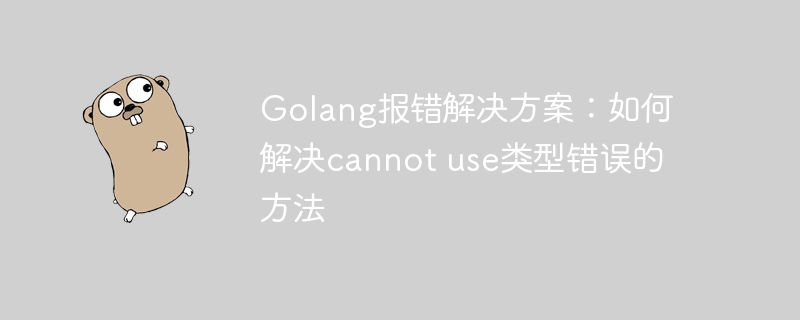Home >Backend Development >Golang >Golang error solution: How to solve the cannot use type error
Golang error solution: How to solve the cannot use type error
- WBOYWBOYWBOYWBOYWBOYWBOYWBOYWBOYWBOYWBOYWBOYWBOYWBOriginal
- 2023-11-25 09:53:511563browse

Golang error solution: How to solve the cannot use type error method
Introduction
Golang is a strongly typed language and is very strict in type matching. When we write code, we sometimes encounter a common error: cannot use. This error usually occurs when a variable of the wrong type is passed as an argument to a function or method. In this article, we will discuss how to fix this type of error and provide some practical solutions.
1. Understand Go’s type system
Before solving the cannot use error, we need to first understand Go’s type system. In Go, every variable has an explicit type, and conversions between types must be explicit. If we try to assign a mismatched type to a variable, the Go compiler will report an error.
2. Check the error message
When we encounter a cannot use error, the first thing to do is to check the error message. The error message usually contains the specific cause and location of the error. By carefully reading the error message, we can better understand the problem and find ways to resolve it.
3. Check the variable type
When solving the cannot use error, the first step is to check the type of the variable involved. We need to make sure that the type of the variable matches the required type. If there is a mismatch, it can be resolved by type conversion.
For example, suppose we have two variables A and B of type int, and we want to convert them to variables C and D of type float64. We can use the following code for type conversion:
C := float64(A)
D := float64(B)
By converting a variable of type int to type float64, we Fixed cannot use error.
4. Use type assertions
If we use an interface type in a method parameter and a cannot use error occurs during assignment, we can use type assertions to solve the problem.
Type assertions can convert variables of interface types into the required types, thereby solving type mismatch problems. Here is an example of using type assertions to resolve the cannot use error:
func processInterface(input interface{}) {
str, ok := input.(string)
if ok {
// 对str进行操作
}}
In the above example, we first Convert the interface type variable input to the string type variable str. By using type assertions, we can ensure that the type of a variable matches the required type.
5. Use type aliases
In some cases, we may encounter situations where we cannot directly change the code, but still need to solve the cannot use error. At this time, we can consider using type aliases to solve the problem.
Type aliases allow us to create a new name for an existing type, making it easy to convert between existing types and new types. By using type aliases we can change the type of variables in our code without changing the entire code.
The following is an example of using type aliases to solve the cannot use error:
type MyInt int
func main() {
var a MyInt = 10 var b int b = int(a) fmt.Println(b)
}
In the above example, we first create a new int type using the type alias MyInt. Then, we convert the variable of type MyInt into the variable b of type int. By using type aliases, we successfully solved the cannot use error.
Conclusion
Type errors are a common problem in Golang programming. In this article, we discussed some practical ways to resolve cannot use type errors. By understanding Go's type system, viewing error messages, checking variable types, and using type assertions and type aliases, we can better understand and resolve such errors. At the same time, we should always pay attention to type matching and follow strongly typed programming principles to avoid such errors.
The above is the detailed content of Golang error solution: How to solve the cannot use type error. For more information, please follow other related articles on the PHP Chinese website!

